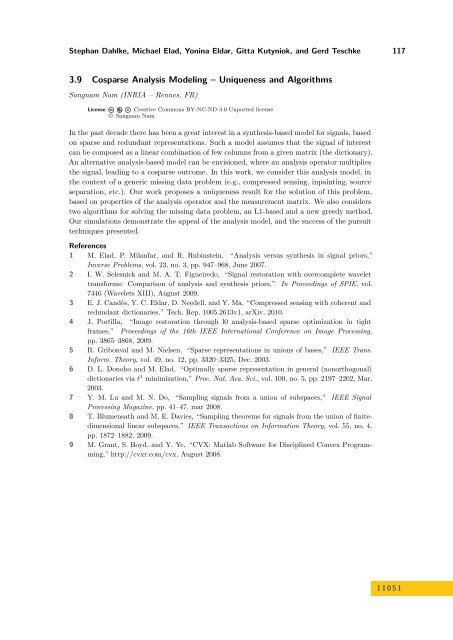Volume 1, Issue 1, January 2011 - DROPS - Schloss Dagstuhl
Volume 1, Issue 1, January 2011 - DROPS - Schloss Dagstuhl
Volume 1, Issue 1, January 2011 - DROPS - Schloss Dagstuhl
You also want an ePaper? Increase the reach of your titles
YUMPU automatically turns print PDFs into web optimized ePapers that Google loves.
Stephan Dahlke, Michael Elad, Yonina Eldar, Gitta Kutyniok, and Gerd Teschke 117<br />
3.9 Cosparse Analysis Modeling – Uniqueness and Algorithms<br />
Sangnam Nam (INRIA – Rennes, FR)<br />
License Creative Commons BY-NC-ND 3.0 Unported license<br />
© Sangnam Nam<br />
In the past decade there has been a great interest in a synthesis-based model for signals, based<br />
on sparse and redundant representations. Such a model assumes that the signal of interest<br />
can be composed as a linear combination of few columns from a given matrix (the dictionary).<br />
An alternative analysis-based model can be envisioned, where an analysis operator multiplies<br />
the signal, leading to a cosparse outcome. In this work, we consider this analysis model, in<br />
the context of a generic missing data problem (e.g., compressed sensing, inpainting, source<br />
separation, etc.). Our work proposes a uniqueness result for the solution of this problem,<br />
based on properties of the analysis operator and the measurement matrix. We also considers<br />
two algorithms for solving the missing data problem, an L1-based and a new greedy method.<br />
Our simulations demonstrate the appeal of the analysis model, and the success of the pursuit<br />
techniques presented.<br />
References<br />
1 M. Elad, P. Milanfar, and R. Rubinstein, “Analysis versus synthesis in signal priors,”<br />
Inverse Problems, vol. 23, no. 3, pp. 947–968, June 2007.<br />
2 I. W. Selesnick and M. A. T. Figueiredo, “Signal restoration with overcomplete wavelet<br />
transforms: Comparison of analysis and synthesis priors,” In Proceedings of SPIE, vol.<br />
7446 (Wavelets XIII), August 2009.<br />
3 E. J. Candès, Y. C. Eldar, D. Needell, and Y. Ma, “Compressed sensing with coherent and<br />
redundant dictionaries,” Tech. Rep. 1005.2613v1, arXiv, 2010.<br />
4 J. Portilla, “Image restoration through l0 analysis-based sparse optimization in tight<br />
frames,” Proceedings of the 16th IEEE International Conference on Image Processing,<br />
pp. 3865–3868, 2009.<br />
5 R. Gribonval and M. Nielsen, “Sparse representations in unions of bases,” IEEE Trans.<br />
Inform. Theory, vol. 49, no. 12, pp. 3320–3325, Dec. 2003.<br />
6 D. L. Donoho and M. Elad, “Optimally sparse representation in general (nonorthogonal)<br />
dictionaries via ℓ 1 minimization,” Proc. Nat. Aca. Sci., vol. 100, no. 5, pp. 2197–2202, Mar.<br />
2003.<br />
7 Y. M. Lu and M. N. Do, “Sampling signals from a union of subspaces,” IEEE Signal<br />
Processing Magazine, pp. 41–47, mar 2008.<br />
8 T. Blumensath and M. E. Davies, “Sampling theorems for signals from the union of finitedimensional<br />
linear subspaces,” IEEE Transactions on Information Theory, vol. 55, no. 4,<br />
pp. 1872–1882, 2009.<br />
9 M. Grant, S. Boyd, and Y. Ye, “CVX: Matlab Software for Disciplined Convex Programming,”<br />
http://cvxr.com/cvx, August 2008.<br />
1 1 0 5 1













